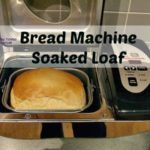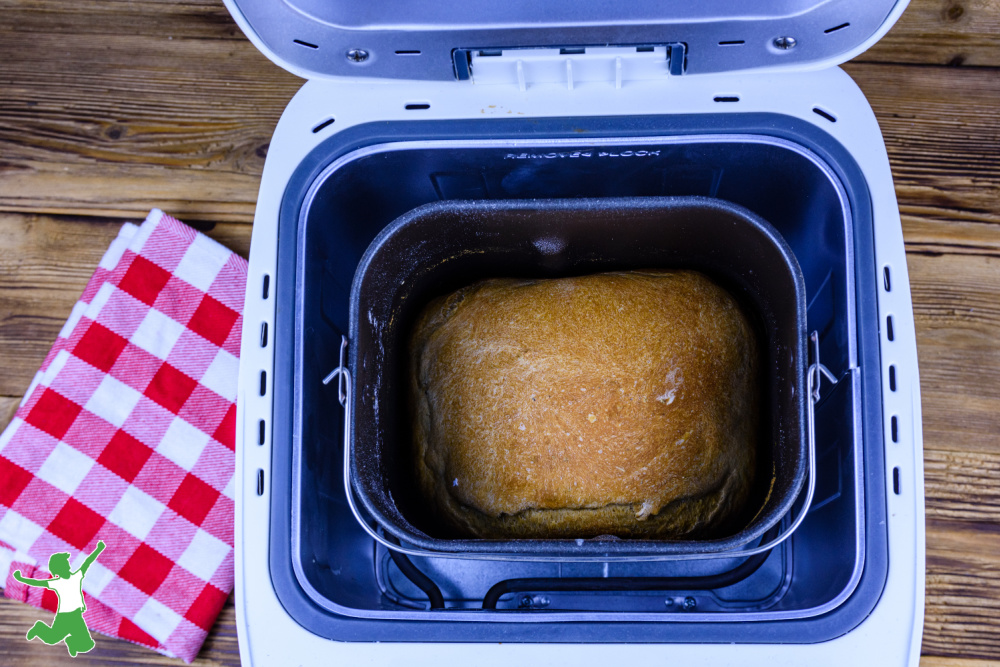Table of Contents[Hide][Show]
A handy bread machine recipe for a delicious, conveniently made loaf using soaked flour for much improved nutrition and digestibility.
Homemade bread is making a comeback! The convenience of using a bread machine recipe is part of the reason why as more and more people opt to make their own with quality ingredients they source themselves.
Quality over convenience is an idea whose time has come in the bread department. The general public is awakening to the dangers of white flour, one of the “displacing foods of modern commerce” as described by Dr. Weston A. Price in his nutritional classic Nutrition and Physical Degeneration.
This is a radical change from even just a few decades ago.
My Grandmother, like many of her generation, always chose white bread over “brown bread” as she called it. She considered whole wheat bread a sign of poverty because she observed growing up that those who ate white bread were more affluent and educated.
Fortunately, this notion is no longer a popular mindset.
Whole Grain Homemade Bread is Best
Not only is bread made with white flour basically devoid of nutrition, but it also adds to the body’s toxic load with a plethora of additives, chemicals, and unhealthy vegetable oils.
Worse, unlike the white bread even just 10 years ago, store bread frequently contains soy flour. This modern food threatens hormonal health and can trigger digestive problems for those who are sensitive.
Even commercially made sprouted bread masquerading as healthy frequently contains seitan or vital wheat gluten. This additive is nearly impossible to digest when isolated for use by food manufacturers.
Consumers choosing to bake their own bread usually forgo white flour in favor of whole wheat or other whole grains. Popular examples include teff or millet.
While whole grain flour may be fresher when you grind it at home and the bread more nutritious, other problems can emerge.
Modern breadmaking using a bread machine recipe typically employs the use of yeast and high heat. This quickly raises the dough and bakes the bread in a short amount of time.
This contrasts with the slow, natural rise that occurs with fermented dough baked at a lower temperature.
Why Use Soaked Flour?
Science has demonstrated the wisdom of the careful preparation methods of our ancestors. All grains and legumes contain phytic acid, an organic acid that blocks mineral absorption in the intestinal tract.
Powerful anti-nutrients in grain flour are neutralized in as little as 7 hours of soaking in water with small amounts of an acidic medium.
Examples include yogurt, kefir, lemon juice or cider vinegar. Soaking also neutralizes enzyme inhibitors present in the hulls of all grains and adds beneficial enzymes that increase the amount of nutrients present – especially the B vitamins.
For those with gluten intolerance, soaking or fermenting gluten-based grains breaks down this difficult-to-digest plant protein; studies carried out in Italy have found that people with celiac disease can consume genuine sourdough bread without digestive distress or auto-immune symptoms.
I frequently get asked how to make fresh bread at home using the traditional method of soaking flour first combined with the modern convenience of a bread machine.
If you have a breadmaker and would like to transition to a traditional method for making bread while continuing to use this appliance, here’s a bread machine recipe to try.
It is adapted from Healthy4Life by the Weston A. Price Foundation.
Enjoy your fresh-baked loaf courtesy of a blend of modern convenience and Traditional Wisdom!

Bread Machine Recipe using Soaked Flour
A handy bread machine recipe for a delicious conveniently made loaf using the traditional preparation method of soaking flour for much-improved nutrition and digestibility.
Ingredients
- 10 Tbl whole yogurt
- 3/4 cup filtered water
- 4 cups whole grain flour less 3 Tbl, preferably freshly ground
- 2 Tbl butter softened
- 1 Tbl molasses
- 3 Tbl arrowroot powder
- 1 3/4 tsp dried yeast
- 1 tsp sea salt
Instructions
-
Mix yogurt with water and mix with the flour to form a dough. Cover and leave in a warm spot on the kitchen counter for 18-24 hours.
-
When it is partway through the kneading section, check that all the ingredients have mixed together and observe the consistency of the dough.
-
If it is slimy, add some more arrowroot powder. If it’s too dry, add a few more drops of water, drop by drop.
-
Proceed as directed for your particular bread machine model to finish baking your traditional loaf!
Once you’ve made your soaked loaf, be sure to save the crusts because they are perfect for making breadcrumbs!
More Traditional Bread Recipes
Interested in traditional breadmaking? Try these other recipes inspired by ancestral wisdom.









Can I sub vital wheat gluten for the arrowroot flour?
Vital wheat gluten is not a healthy addition to homemade bread. It is a very hard to digest plant protein and should never be added to anything.
I tried this for the first time this past weekend, with my new Beem bread machine. I used what I had on hand– honey instead of molasses and whey instead of yogurt. The dough looked great during the kneading and rising cycles, but when the baking finished I discovered a doughy loaf that sank in the middle and did not bake except for the edges–heavy as a bowling ball, too. I’m so disappointed, but scared to try again for fear I waste any more ingredients.
Rachel, This is a good recipe but here is a link to an even better one. Have made this 3 times now, and each time it has turned out well. My only changes are, I don’t use arrowroot powder to roll out the bread. I butter my hands and cutting board and roll it out. Because I don’t use arrowroot powder, the dough maybe a little soft, this will result in a more coarse bread. So when you put the bread on to soak, I make sure the dough is not too soft adding a little more flour it I need to.
http://www.weedemandreap.com/2013/07/easy-delicious-soaked-whole-wheat-bread-with-video.html
I hope this works well for you. By the way, I have had my bread from the recipe you used turn out the same way. Not always, but once in a while. This other recipe taste very good too.
Terri
Hi, Terri,
This sounds like a really good recipe, but I am very leary of the ascorbic acid because it is my understanding that it is derived from GMO corn. Is there a healthy alternative to ascorbic acid? Thanks 🙂
Thank you so much for this bread recipe. When I soaked it, it was very dry. I looked at it later and decided (after reading all of the comments) to add 1/2 cup more water. I live in the southwest and it’s very dry here. I thought it was wasted and that I would have to throw it out. But then when I put it in my electrolux mixer, it mixed up beautifully.
Thanks also to Terrie who showed how to make it in a mixer and bread pans. I appreciate this soaked bread recipe. Now to try it!
When I do the first step of mixing water, yogurt, and flour together, the mixture is extremely dry, and hard to mix by hand. To then add arrowroot at a later rime seems unnecessary. I have tried this a couple times and it never seems to come out right. I would love for this to work…any suggestions?
Thank you.
hi
this looks great – i would need to replace the dairy somehow. i know how i’d replace the butter – but what about the yogurt? any ideas would be awesome, thanks.
Hi,
I have tried this recipe four times but I can’t get it to rise. Do you have suggestions?
I have a Breadman bread machine and I do not have a whole meal option, do you have advice to which setting to use? I have a whole wheat setting. Thank you.
Hi! Thanks for the post. I have tried this recipe twice using the exact methods and ingredients shown, but had to add about 5 extra Tablespoons of arrowroot because the dough was way too gooey after it had gone partway through the dough cycle. It had the consistency of batter instead of dough! I ended up with a hard lump that did not rise. I’d love additional instructions or troubleshooting advice. Thanks!
Hi Jessica,
When I first start, I put the flour in my Bosch, and then add yogurt (I have used whey) until I get a soft ball. The measurements are not right. I do not use a bread machine. So I am playing with the dough at the first step. I do not know what to do with a bread machine, but I think it should be about the same. I have never added more arrowroot. Just flour if I get the first step too wet. I hope this helps.
Terri
Thanks Terri, That really helps. Mine turned out way to sticky and was like a brick too. Will try again using your suggestions.